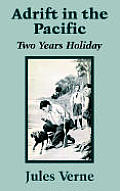Years before Lord of the Flies
William Golding’s Lord of the Flies sits in a long line of novels about shipwrecked voyagers stretching back to the beginning of the English novel with Daniel Defoe’s Robinson Crusoe.
Other famous examples of the “Robinsonade” genre include Gulliver’s Travels, The Swiss Family Robinson, Enoch Arden, Haakon Haakonsen: En Norsk Robinson, Treasure Island, The Blue Lagoon, The Black Stallion, and Island of the Blue Dolphins.
The example that Golding cited as inspiration was The Coral Island and a Tale of the South Pacific, by R. M. Ballantyne. He explicitly alluded to that book twice in Lord of the Flies and borrowed two of its main characters’ first names. In Ballantyne’s tale three boys are shipwrecked on an island, look after themselves and friendly natives, fight off pirates and unfriendly natives, and convert natives to Christianity. Really their island’s not that deserted.
One novel resembles Lord of the Flies in its premise a lot more: Deux ans de vacances (Two Years’ Vacation, also titled Adrift in the Pacific, A Two Years’ Holiday, and A Long Vacation), written by Jules Verne in 1888. Verne liked Robinsonades, publishing two others before this one: The Mysterious Island (titled L’Oncle Robinson in its first, discarded version) and Godfrey Morgan.
In Deux ans de vacances, a group of mostly British schoolboys are cast ashore on an uninhabited, unmapped island. They organize themselves into a rudimentary society, the older boys looking after the younger ones. They hunt wild animals. They see no other humans for two years until a ship comes by.
In those respects, Lord of the Flies is more like Deux ans de vacances than The Coral Island or any of its predecessors. And the similarities don’t stop with the thick lines of plot. In the first English edition of Verne’s novel, titled Adrift in the Pacific, the younger boys are frequently referred to as “little ones.” In Lord of the Flies, the younger boys are “littluns.” (The 1967 translation of Deux ans de vacances, titled A Long Vacation, comes up with the jargon “Elbees,” short for “little boys.”)
There’s no evidence that Golding ever read Deux ans de vacances. The 1889 British version was reprinted in 1927, 1934, and perhaps other years, however. Golding said he and his wife shared a number of island adventure stories before he got the idea to write about how boys would really behave on an island. Adrift in the Pacific might have been one of them. If not, then there are some mighty strong coincidences.
Other famous examples of the “Robinsonade” genre include Gulliver’s Travels, The Swiss Family Robinson, Enoch Arden, Haakon Haakonsen: En Norsk Robinson, Treasure Island, The Blue Lagoon, The Black Stallion, and Island of the Blue Dolphins.
The example that Golding cited as inspiration was The Coral Island and a Tale of the South Pacific, by R. M. Ballantyne. He explicitly alluded to that book twice in Lord of the Flies and borrowed two of its main characters’ first names. In Ballantyne’s tale three boys are shipwrecked on an island, look after themselves and friendly natives, fight off pirates and unfriendly natives, and convert natives to Christianity. Really their island’s not that deserted.
One novel resembles Lord of the Flies in its premise a lot more: Deux ans de vacances (Two Years’ Vacation, also titled Adrift in the Pacific, A Two Years’ Holiday, and A Long Vacation), written by Jules Verne in 1888. Verne liked Robinsonades, publishing two others before this one: The Mysterious Island (titled L’Oncle Robinson in its first, discarded version) and Godfrey Morgan.
In Deux ans de vacances, a group of mostly British schoolboys are cast ashore on an uninhabited, unmapped island. They organize themselves into a rudimentary society, the older boys looking after the younger ones. They hunt wild animals. They see no other humans for two years until a ship comes by.
In those respects, Lord of the Flies is more like Deux ans de vacances than The Coral Island or any of its predecessors. And the similarities don’t stop with the thick lines of plot. In the first English edition of Verne’s novel, titled Adrift in the Pacific, the younger boys are frequently referred to as “little ones.” In Lord of the Flies, the younger boys are “littluns.” (The 1967 translation of Deux ans de vacances, titled A Long Vacation, comes up with the jargon “Elbees,” short for “little boys.”)
There’s no evidence that Golding ever read Deux ans de vacances. The 1889 British version was reprinted in 1927, 1934, and perhaps other years, however. Golding said he and his wife shared a number of island adventure stories before he got the idea to write about how boys would really behave on an island. Adrift in the Pacific might have been one of them. If not, then there are some mighty strong coincidences.



No comments:
Post a Comment